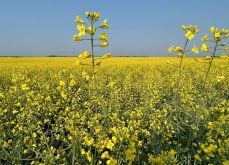BOISSEVAIN, Man. – The dawn of a new day brings a sense of calm to the farm of Walter and Betty Albrecht near this southwestern Manitoba farm.
Cows chew lazily as a steady breeze skims across the pasture and delivers a soothing warmth.
It looks like a bountiful year may be unfolding at the Albrecht farm – there’s plenty of pasture, the crops look promising and there’s already a large mound of silage set aside for winter feed.
But for Walter and his son, Darryl, 29, there’s little time to bask in the sun’s warmth. There’s hay to bale, fields to monitor, cattle to check and equipment to be readied for harvest.
Read Also

StatCan stands by its model-based crop forecast
Statistics Canada’s model-based production estimates are under scrutiny, but agency says it is confident in the results.
Walter grows tense during the haying season. This year humid weather has delayed baling in an alfalfa field by more than a week. Quality is at stake.
“A person gets fairly uptight,” said Walter, who has been a farmer for 37 years. “We try not to allow that to happen, but it’s bound to happen.”
Weather has been both friend and foe this year. Spring began with a dry spell, followed by heavy rains that lasted through most of June. Pastures and hay fields flourished in the moist conditions, but so did some crop diseases and pest insects.
Deciding whether to spend money on sprays would be easier, said Walter, if they knew what price to expect from their fall harvest. Grain prices are never constant and it’s too soon to know how many bushels they’ll have in their bins this fall.
“It does give you a long face when you see diseases in the fields,” Walter said. “You try to stay as positive as you can. If you can do that, you’ll go a long way.”
Darryl swings from excitement to uneasiness as he talks about the long-term plans for the farm. During the past couple of years, they’ve been shifting from a grain emphasis to more cattle. They hope to background about 300 calves this winter.
“There is a little bit of apprehension,” he said. “You’re changing the farm and you don’t always know if you’re making the right decisions. Hopefully it’ll improve the farm and improve the bottom line.”
Walter and Darryl share a determination to succeed. Besides expanding their feedlot, they’ve introduced a zero tillage system to their farm and they want to produce more custom silage. They’re also building more fences to take advantage of rotational grazing.
“Sometimes our plans don’t move as fast as we want,” said Walter, “and maybe that’s OK too. Maybe there are times when it’s better to walk before you run right away.”
Despite the tumultuous times, Walter and Darryl harbor no desire to leave farming. For Darryl, part of the appeal is the chance to be outdoors in the fresh air and sunshine. He also enjoys the freedom.
Walter can’t imagine working for someone else. He still draws pleasure from the sight of a newborn calf or a field of wheat waving in the wind.
“It puts a smile on your face regardless of the price.”
Walter plans to retire from farming in five years. Darryl and his younger brother Ryan are assumed to be the heirs apparent. Ryan works at a nearby cattle company and has started to build up a herd.
In the meantime, Walter gives his sons room to make decisions on their own. By doing so, he hopes Darryl and Ryan will also have the opportunity to dream.
















